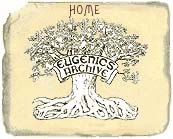
Development and Rationale of Our Privacy Policy
From the outset of this project, we have been cognizant that the images in this archive and the ideas expressed by eugenicists are potentially offensive. Eugenics cast a negative light on every racial, ethnic, and disabled group. Many of the things that eugenicists did and said were bigoted and hurtful.
Therefore, the conceptualization and development of this World Wide Web (WWW) site was guided by an Editorial Advisory Panel (EAP) composed of historians, sociologists, scientists, and representatives of minority and disabled communities. This panel discussed for 30 hours how the materials should be presented and what measures should be taken to protect the privacy of recognizable individuals, families, and pedigrees. We believe the privacy policy that emerged from panel deliberation provides a reasonable balance between historical "right-to-know" and personal privacy protection.
Although they vary from state to state, privacy laws generally hold that 1) privacy rights cease upon death of the individual and 2) a person has no legitimate privacy claims against items already in the public domain. Thus, the vast majority of items in the Archive are technically exempt from privacy claims, since they deal with deceased persons or are taken from published works. However, we decided to consider the relevant privacy issues according to more stringent ethical standards. We acknowledged that the mere fact that an image is in the public domain does not diminish the dignitary harm it may inflict. We also acknowledged that, in a genetic sense, personal privacy does extend beyond death to surviving relatives. In addition, we considered the risks of group stigmatization that could potentially result from identifying disabled people using out-of-date or offensive terms.
While recognizing these potential risks, we ultimately concluded that the minimal personal risks to the individuals portrayed in the Archive, their surviving relatives, and the groups with which they may be associated are substantially outweighed by the potential societal benefits of making these materials widely available for study. These benefits include the opportunity to teach students and the general public about a part of American history that is not generally known and the opportunity to sensitize individuals to the present-day implications of the eugenics movement.
Thus, after serious deliberation, we adopted a single key provision to provide limit the likelihood that individuals can be identified: Names and place identifiers are removed from all personal photographs and pedigrees in the Archive.
Assuming that a very few of the individuals portrayed in the Archive may still be alive, it is unlikely that they would come into contact with Archive. In the unlikely case that living relatives come in contact with the Archive and can identify a portrayed individual, any harm would be essentially derivative and intangible. Likewise, we believe it unlikely that third parties would be able to identify individuals so far removed in time, without name or place identifiers.
